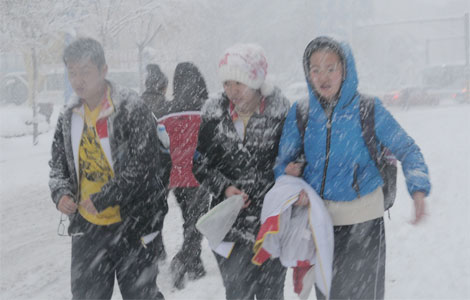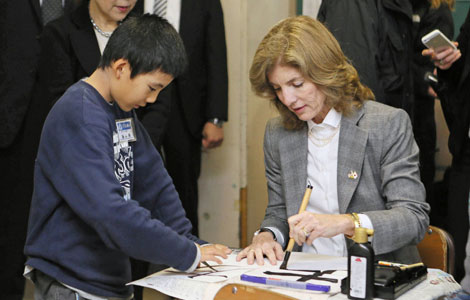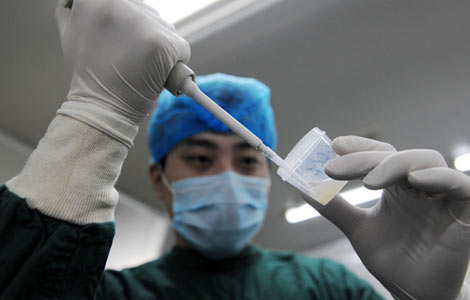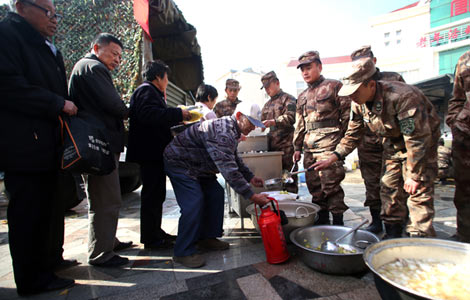
Nation is becoming a steppingstone for Chinese investors to enter the African market, reports Yao Jing
While some African countries feel uneasy about the unbalanced pattern of trade between China and Africa, Chinese manufacturers and investors see South Africa as a ticket to the continent and both sides are broadening links to help rebalance trade ties.
Two-way trade between China and Africa hit $198.49 billion in 2012, and China's trade with South Africa alone reached $60 billion, which is a fortyfold jump since 1998 when the two countries established diplomatic relations, according to figures from the Ministry of Commerce.
"As the biggest economy in Africa, Chinese companies tend to march into South Africa as a first step in going global," said Zhang Xialing, deputy director-general of the foreign trade department of the Ministry of Commerce, at the 114th Canton Fair, which ended on Nov 4 in Guangzhou, Guangdong province.
China has been South Africa's largest trading partner, the biggest export market and also the largest source of imports for four consecutive years. At the same time, South Africa is China's biggest trading partner in Africa. More than 130,000 Chinese visitors went to South Africa in 2012, up 56 percent compared with 2011.
"We are encouraging Chinese importers to buy more agricultural products, wines and chemical products from South Africa and deepen bilateral cooperation in manufacturing. It is also important for us to develop partnerships in emerging industries, such as traveling," said Cao Jiachang, deputy director-general of the department of West Asian and African affairs of the Ministry of Commerce.

In fact, China-South Africa links have broadened in recent years, rather than being limited to raw materials that some have regarded as an exploitative drive for Africa's natural resources.
Minerals have been South Africa's major exporting goods to China. However, the proportion of this sector is witnessing a steady drop and the transformation of foreign trade between China and South Africa seems to be bubbling.
In 2012, the value of South Africa's minerals shipped to China decreased 14.8 percent to $7.73 billion. The total exports of its base metals to China also declined - 27.1 percent from 2011.
However, China imported more textiles and related raw materials from South Africa, totaling $200 million, an increase of 46.5 percent compared with 2011, according to the Ministry of Commerce.
On the Chinese side, apart from exporting traditional manufactured goods to Africa, such as electronics and clothes, Chinese companies are shifting to an upper-end market and also adding direct investments.
Chinese consumer electronics company Hisense Group invested 350 million yuan ($56 million) for an electronics factory in Atlantis, north of Cape Town in June.
Hisense started manufacturing flat-screen televisions and refrigerators at the plant in February, recruiting and training 300 previously unemployed residents from the area.
South Africa was Hisense's first market in Africa, which it entered in 1995. Until now, its turnover from South Africa accounts for 16 percent of the company's total income in Africa.
"In 2010, we adjusted our strategy in South Africa, from selling low-end products to high-end ones. Right now, our pricing in Africa is almost equal to international brands such as LG and Samsung," said Zhu Dan, president of Hisense Middle East-Africa Holdings Co Ltd.
"The market is growing at an average pace of 20 percent year-on-year. Our refrigerators, televisions as well as air conditioners are very popular in the marketplace," Zhu said.
Zhu added that they simply expected to sell as many products as possible in past years. However, as the market has changed, the company decided to position itself as an international brand. It made changes in its management, product mixture and selling channels.
According to data from Germany-based research firm GfK Group, in South Africa, the market share for Hisense refrigerators grew from 8 percent to 12 percent from January 2012 to June 2012, ranking it third behind two local brands, KIC and DEFY Appliances.
Hisense high-end series of refrigeration products have been available at Dion, South Africa's high-end home appliance channel, and Hirsh, a high-end single shop, since 2011. In 2012, Hisense refrigeration products have been brought into two more channels, Mass Mart and Pick n Pay, which belong to Wal-Mart Stores Inc.
The company said that it plans to double the size of the factory over the next few years and increase its staff to 1,000, with a view to extending the production of washing machines, air-conditioning units and, possibly, wine coolers and coffee machines.
"We are confronted with the problem of how to better localize. We hope to have more local senior talent, not just workers. Currently, about 50 percent of our workers are Chinese," Zhu said.
However, not every Chinese maker is as lucky as Hisense in establishing an authentic brand in the process of expanding in the market.
As a latecomer to South Africa, Qingdao Hichanse Group Co Ltd is still selling original equipment manufactured products there.

"We began to work with our agent in South Africa in 2009. After two years' flat growth, our business started to boom in 2012, when our sales volume increased 50 percent compared with 2011. Meanwhile, we launched our own branded kitchen ventilator after our agent asked for it," said Jiang Hongxia, a sales manager with Qingdao Hichanse Group.
In general, the company exported fewer than 2,000 kitchen ventilators in 2012, each costing $300 to $400. Still, original equipment manufactured products account for 90 percent of the company's total business in the market.
"We have got certification in the market but we lack information about buyers or dealers. It is much more difficult to operate our own brand in the marketplace," Jiang said.
Competitive edge
Compared with local products, Jiang said Chinese makers are gaining competitive edge in terms of quality and design, especially in the upper-end market.
"But we are also losing customers because we are not as competitive as local producers because we have problems with after-sales services as well as finding distribution channels," said Jiang.
Because it is much easier for buyers to accept products with new technology and design, Jiang said her company will focus on the middle- and high-end market, while continuing to update products.
In addition to expanding sales abroad, experts said it is also important for Chinese exporters to develop brands because branded names are gaining popularity in the market.
"I am very confident about the future of South Africa's small appliances, food and personal-care markets because the cooperation between China and South Africa is diversifying," said Roger Carbonell, commercial director of consumer choices with Sub-Saharan Africa at GfK Retail & Technology Group.
Carbonell said price increases in high-value segments combined with price erosion in mass categories were because at first glance the market was sluggish.
When it comes to how to solve Chinese exporters' sales channel problems, Carbonell said modern and formalized retail structures are dominating the market.
Therefore, breaking into the established mature system is something of a challenge for Chinese sellers.
"As for small appliances, the mid-tier market is declining. You either build strong brands or you become highly price-aggressive," said Carbonell.
Contact the writer at yaojing@chinadaily.com.cn
(China Daily 11/26/2013 page13)














